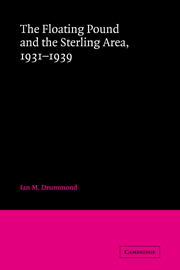Book contents
- Frontmatter
- Contents
- Preface
- 1 Introduction: the sterling area in the 1930s
- 2 Sterling and the rupee
- 3 The Canadian debate over money and exchanges, 1930–1934
- 4 South Africa, sterling, and the gold standard, 1931 and thereafter
- 5 Australia and New Zealand, 1930–1939
- 6 Monetary preparations for the World Economic Conference
- 7 United Kingdom policy at the World Monetary and Economic Conference
- 8 Talking about exchange stabilization, autumn 1933 through June 1936
- 9 The Tripartite Agreement of 1936
- 10 Intergovernmental conversations and the management of sterling, 1936–1939
- 11 Conclusion: the significance of sterling
- Notes
- Index
2 - Sterling and the rupee
Published online by Cambridge University Press: 07 October 2011
- Frontmatter
- Contents
- Preface
- 1 Introduction: the sterling area in the 1930s
- 2 Sterling and the rupee
- 3 The Canadian debate over money and exchanges, 1930–1934
- 4 South Africa, sterling, and the gold standard, 1931 and thereafter
- 5 Australia and New Zealand, 1930–1939
- 6 Monetary preparations for the World Economic Conference
- 7 United Kingdom policy at the World Monetary and Economic Conference
- 8 Talking about exchange stabilization, autumn 1933 through June 1936
- 9 The Tripartite Agreement of 1936
- 10 Intergovernmental conversations and the management of sterling, 1936–1939
- 11 Conclusion: the significance of sterling
- Notes
- Index
Summary
In the historiography of Indian nationalism, the “question of rupee ratio” regularly obtrudes itself. By the “ratio” is meant the exchange rate between the rupee and sterling. Should the rupee have been worth one shilling and fourpence, as before 1914; two shillings, as briefly in 1920; or one shilling and sixpence, as from October 1924 until long after 1939? Should it have been pegged to gold, to sterling, or to nothing in particular? Because a cheaper rupee implied a more protected domestic market for Indian producers, neither industrial opinion nor the Congress Party was prepared to ignore the question. In the 1920s Congress pressed for devaluation at least to the prewar level of 1/4. London was adamant in its determination to keep the rupee at one shilling and sixpence. Expatriate officials, as we shall see, often disagreed with Whitehall policy. But as B. R. Tomlinson has recently shown, Whitehall prevailed.
In this chapter we first trace the arguments that lay behind the Whitehall position and the expatriate officials' efforts to change that position in 1931. Our discussion parallels Tomlinson's work and relies on most of the same materials, but the emphasis is perhaps somewhat different. We then turn to some later developments, where we shall see that the rupee exchange rate and the management of the sterling-rupee exchange were closely intertwined with the movement of India toward responsible self-government.
- Type
- Chapter
- Information
- The Floating Pound and the Sterling Area1931–1939, pp. 28 - 51Publisher: Cambridge University PressPrint publication year: 1981

